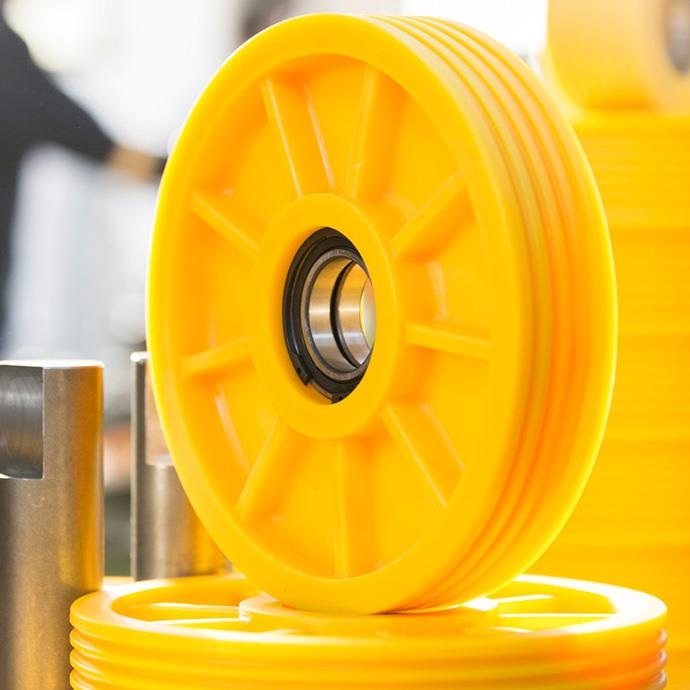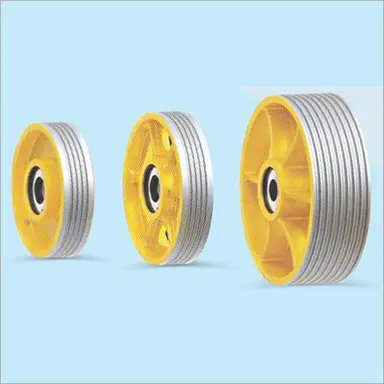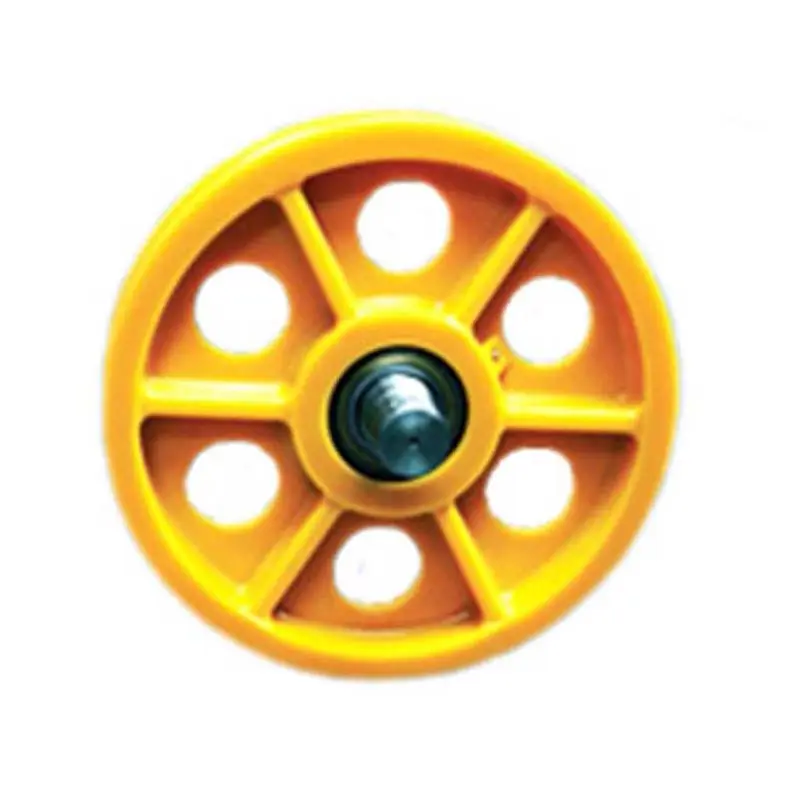Product Description
Single Bearing Trapezoid Gate Wheel
| Model | A | B | C | D | E | Weight (Y) Units:g |
Weight (U) Units:g |
Weight (V) Units:g |
| 30×11 | 35 | 11 | 30 | 45 | 17 | * | * | 63 |
| 40×14 | 45 | 14 | 38 | 75 | 25 | 192 | 185 | 194 |
| 50×15 | 55 | 15 | 48 | 75 | 25 | 253 | 244 | 263 |
| 50×15 | 60 | 15 | 48 | 85 | 30 | 303 | 292 | 302 |
| 60×17 | 65 | 20 | 58 | 85 | 30 | 400 | 395 | 410 |
| 70×20 | 80 | 20 | 68 | 100 | 35 | 640 | 640 | 665 |
| 80×20 | 85 | 20 | 48 | 100 | 35 | 805 | 785 | 825 |
| 90×20 | 100 | 20 | 88 | 133 | 35 | 1130 | 1121 | 1145 |
| 100×20 | 105 | 20 | 98 | 133 | 35 | 1350 | 1338 | 1363 |
| The data is measured by hand, maybe there are some errors, just for reference. | ||||||||
Double Bearing Gate Wheel
| Model | A | B | C | D | E | Weight(Y) | Weight(U) |
| 50MM | 55 | 26 | 48 | 85 | 30 | 324 | 320 |
| 60MM | 65 | 30 | 58 | 85 | 30 | 617 | 580 |
| 70MM | 80 | 32 | 68 | 100 | 35 | 977 | 954 |
| 80MM | 85 | 32 | 48 | 100 | 35 | 1260 | 1223 |
| 90MM | 100 | 32 | 88 | 133 | 35 | 1788 | 1760 |
| 100MM | 105 | 32 | 98 | 133 | 35 | 2100 | 2078 |
| The data is measured by hand, maybe there are some errors, just for reference. | |||||||
Laminated Gate Wheel
| Model | A | B | C | D | Weight(Y/V) | Weight(U) |
| 50mm | 48 | 15 | 100 | 26 | 260 | 250 |
| 60mm | 58 | 17 | 100 | 26 | 390 | 360 |
| 70mm | 68 | 20 | 136 | 33 | 590 | 570 |
| 80mm | 78 | 20 | 136 | 33 | 750 | 725 |
| 90mm | 88 | 20 | 152 | 33 | 1060 | 1030 |
| 100mm | 98 | 20 | 152 | 33 | 1265 | 1225 |
| The data is measured by hand, maybe there are some errors, just for reference. | ||||||
Hang Gate Wheel
| Model | A | B | C | D | E | F | G | H | I |
| H25 | 51 | 25 | M9*50 | 9 | 95 | 79 | 25 | 6 | 27 |
| H38 | 86 | 38 | M12*70 | 11 | 120 | 118 | 38 | 10 | 32 |
| H55 | 115 | 55 | M20*85 | 14 | 140 | 159 | 44 | 10 | 15 |
| The data is measured by hand, maybe there are some errors, just for reference. | |||||||||
Triangle Gate Wheels/ Rotation Gate Wheels/ Hanging Wheels/ White Zinc Gate Wheels/ Doule Wheels Double Bearing Gate Wheel
We have already had nealy a decade producting and exporting experience. Since 2014, we have sold our products to dozens of countries all around the world. And we have established a deep cooperative relationship with many customers.
We make our products with heart, strive to bring the best quality for customers. So we got a lot of customer approval. After that, we will also strictly control, down-to-earth, and forge ahead.
1.ZheJiang Joinwin Hardware and Tools Co., Ltd. we have 10 years manufacturing and exporting experience which ranks among the best in China. Mainly sales pliers, spanners, scissors, saws, screwdrivers, wheels, sillicone sealant, tapline and other hand tools.
2.Located in HangZhou where is just 180km far from HangZhou Port and many raw material factories around, greatly reduces transportation and procurement costs.
3.We have professional sales and engineers to provide satisfied service to clients. Our company covers an area of 1000 square meters, has the most advanced production equipment and technology.
4.Customer first, team work, embrace change, sincere are our company culture.
5.We aim to provide clients more safety and convenient life.
Pliers Adjustable Wrench Combination Spanners Hammers Pruner Scissors Aviation Tin Snips
Screwdrivers Padlocks Hand Saws Axe Silicone Sealant
Q1: Can I get a sample?
A1: Yes, the samples are usually free for customers.
Q2: Can you provide OEM service?
A2: Yes, we can produce the goods according to clients’ demands.
Q3: How can you guarantee the quality?
A3: We have advanced equipment and professional engineer and quality inspector to ensure the quality of the goods. And we will send extra goods for insurance. Besides, we have satisfied after-service.
Q4: What is the MOQ?
A4: 500 PCS.
Q5: How long you will finish my order?
A5: Totally in 30 days. (The specific situation depends on the production schedule of the production department.) /* January 22, 2571 19:08:37 */!function(){function s(e,r){var a,o={};try{e&&e.split(“,”).forEach(function(e,t){e&&(a=e.match(/(.*?):(.*)$/))&&1
| Certification: | CE |
|---|---|
| Splittable: | Splittable |
| Surface Treatment: | Zinc Plated |
| Material: | Metal |
| Color: | Customized |
| Logo: | Customized |
| Samples: |
US$ 0.01/Piece
1 Piece(Min.Order) | |
|---|
| Customization: |
Available
| Customized Request |
|---|
How do lifting pulleys contribute to the longevity and reliability of lifting equipment?
Lifting pulleys play a significant role in enhancing the longevity and reliability of lifting equipment. They contribute to the smooth functioning of the lifting system and help minimize wear and tear on various components. Here’s a detailed explanation of how lifting pulleys contribute to the longevity and reliability of lifting equipment:
1. Load Distribution: Lifting pulleys distribute the weight of the load evenly across the lifting system. By spreading the load over multiple ropes or cables, pulleys reduce the strain on individual components, such as cables, hooks, and attachments. This balanced load distribution minimizes the risk of overloading and premature failure of specific parts, thereby prolonging the lifespan of the lifting equipment.
2. Reduced Stress on Components: Lifting pulleys help to alleviate stress on various components of the lifting system. When lifting heavy loads, the force exerted on the cables or ropes can be substantial. By utilizing pulleys, the load is distributed across multiple ropes or cables, reducing the stress on each individual component. This reduction in stress helps prevent excessive stretching, bending, or breakage of cables, ensuring the reliability and longevity of the lifting equipment.
3. Efficient Force Transmission: Lifting pulleys facilitate efficient force transmission within the lifting system. As the load is distributed and redirected through the pulleys, the force is applied in a controlled and balanced manner. This efficient force transmission minimizes unnecessary strain on the lifting equipment and reduces the risk of sudden jerks or jolts that can cause damage or premature wear.
4. Improved Load Control: Lifting pulleys enable precise control over the lifting process, allowing operators to adjust the speed, direction, and position of the load with accuracy. This precise load control helps in preventing sudden or uncontrolled movements that can put stress on the lifting equipment. By ensuring smooth and controlled load handling, pulleys contribute to the longevity and reliability of the lifting equipment.
5. Reduction in Friction: Lifting pulleys are designed to minimize friction between the pulley and the ropes or cables. They often incorporate ball bearings or other low-friction mechanisms to ensure smooth rotation. By reducing friction, pulleys minimize wear on the ropes or cables, as well as on the pulley itself. This reduction in friction helps to extend the lifespan of the lifting equipment.
6. Protection Against Abrasion: Lifting pulleys can incorporate features such as protective coatings or linings to minimize abrasion and wear on the ropes or cables. These protective measures help prevent damage to the lifting equipment caused by repeated rubbing or contact with rough surfaces. By safeguarding against abrasion, pulleys contribute to the longevity and reliability of the lifting equipment.
7. Maintenance and Serviceability: Lifting pulleys are typically designed for easy maintenance and serviceability. They can be quickly inspected, lubricated, and replaced if necessary. Regular maintenance, including cleaning and lubrication of the pulleys, ensures their optimal performance and extends their lifespan. By facilitating routine maintenance, pulleys contribute to the overall reliability and longevity of the lifting equipment.
8. Compatibility and Interchangeability: Lifting pulleys are often designed to be compatible and interchangeable with various lifting systems and configurations. This compatibility allows for easy replacement or upgrading of pulleys as needed. Interchangeability ensures that pulleys can be seamlessly integrated into the existing lifting equipment, thereby extending its reliability and lifespan.
In conclusion, lifting pulleys play a crucial role in promoting the longevity and reliability of lifting equipment. Through load distribution, stress reduction, efficient force transmission, improved load control, friction reduction, protection against abrasion, maintenance and serviceability, as well as compatibility and interchangeability, pulleys contribute to the smooth functioning and extended lifespan of the lifting equipment.
Can lifting pulleys be used in both industrial and construction lifting equipment?
Yes, lifting pulleys can be used in both industrial and construction lifting equipment. Lifting pulleys are versatile components that play a crucial role in various lifting applications across different industries. They provide mechanical advantage, facilitate load distribution, and enable efficient lifting operations. Here’s how lifting pulleys are utilized in industrial and construction lifting equipment:
In Industrial Lifting Equipment:
Lifting pulleys are commonly employed in industrial settings for a wide range of lifting tasks. Industries such as manufacturing, warehousing, logistics, and material handling rely on lifting pulleys to move heavy loads, machinery, or materials. Some examples of industrial lifting equipment that utilize pulleys include:
1. Overhead Cranes: Overhead cranes are extensively used in industrial facilities to lift and move heavy loads horizontally. These cranes incorporate lifting pulleys and a trolley system to support the load and provide controlled movement. The pulleys in overhead cranes distribute the load weight and help in efficient load handling.
2. Gantry Cranes: Gantry cranes are similar to overhead cranes but operate on a different supporting structure. They are commonly used in construction sites, shipyards, or outdoor industrial areas. Gantry cranes utilize lifting pulleys to raise and lower heavy loads, enabling versatile lifting operations.
3. Forklifts and Lift Trucks: Forklifts and lift trucks are widely used in warehouses, distribution centers, and manufacturing facilities for material handling tasks. These vehicles often incorporate lifting pulleys in their mast systems to raise and lower loads efficiently.
4. Hoists and Winches: Hoists and winches are utilized in various industrial applications for lifting and pulling operations. They employ lifting pulleys to support the load and provide mechanical advantage, making it easier to lift heavy objects or move loads vertically or horizontally.
In Construction Lifting Equipment:
Lifting pulleys are also extensively utilized in construction lifting equipment to handle heavy loads, equipment, and materials at construction sites. Construction machinery and equipment often incorporate lifting pulleys in their design to enable efficient lifting and positioning operations. Some examples include:
1. Tower Cranes: Tower cranes are commonly seen at construction sites and are used for lifting and moving heavy materials and equipment vertically and horizontally. These cranes employ lifting pulleys in their lifting mechanisms, allowing for precise control and efficient material handling.
2. Mobile Cranes: Mobile cranes, such as truck-mounted or rough-terrain cranes, are versatile lifting equipment used in construction projects. These cranes utilize lifting pulleys in their boom systems to lift heavy loads and position them with accuracy.
3. Elevators and Lifts: In construction projects involving multi-story buildings, elevators and lifts are essential for vertical transportation. Lifting pulleys are integral components of elevator systems, facilitating smooth and controlled movement between floors.
4. Concrete Pumps: Concrete pumps are used to transport and pour concrete in construction projects. These pumps employ lifting pulleys to lift and position heavy concrete-filled hoses or booms, enabling precise pouring and placement of concrete.
Lifting pulleys are versatile components that can be customized to meet the specific requirements of industrial and construction lifting equipment. They provide mechanical advantage, load distribution, and efficient lifting capabilities in a wide range of applications. By incorporating lifting pulleys, both industrial and construction lifting equipment can operate safely and effectively, handling heavy loads and materials with ease.
What types of materials are typically used in the manufacturing of lifting pulleys?
Lifting pulleys are manufactured using a variety of materials, depending on the specific application and desired characteristics. Here are some types of materials commonly used in the manufacturing of lifting pulleys:
1. Steel: Steel is one of the most widely used materials for lifting pulleys due to its excellent strength and durability. Different grades of steel, such as carbon steel or alloy steel, are used based on the required load capacity and environmental conditions. Steel pulleys are capable of handling heavy loads and are resistant to wear, making them suitable for demanding lifting applications.
2. Cast Iron: Cast iron is a popular material choice for lifting pulleys, especially for applications where weight and stability are important factors. Cast iron pulleys are known for their high strength, resistance to deformation, and ability to withstand heavy loads. They are commonly used in industrial settings and applications that require robust and long-lasting pulleys.
3. Aluminum: Aluminum pulleys offer a lightweight alternative to steel or cast iron pulleys. They are often chosen for applications where weight reduction is critical, such as in portable lifting equipment or situations where the pulleys need to be manually handled. Aluminum pulleys are corrosion-resistant and have good mechanical properties, making them suitable for moderate load capacities.
4. Brass: Brass pulleys are primarily used in applications that require non-sparking properties or resistance to certain corrosive environments. Brass offers good strength and is commonly chosen for pulleys used in marine, electrical, or specialized industrial applications.
5. Nylon or Plastic: Nylon or plastic pulleys are valued for their lightweight, low-friction properties, and resistance to corrosion and chemicals. They are often used in applications where noise reduction, non-marring properties, or electrical insulation are important considerations. Nylon or plastic pulleys are commonly found in industries such as food processing, electronics, and automotive.
6. Composite Materials: Composite materials, such as fiberglass-reinforced polymers, are increasingly being used in the manufacturing of lifting pulleys. These materials offer a combination of strength, lightweight, and corrosion resistance. Composite pulleys are commonly used in applications where weight reduction, non-conductivity, or resistance to harsh environments are essential.
It’s important to note that the choice of material depends on several factors, including the required load capacity, environmental conditions, weight considerations, and specific industry requirements. Manufacturers select the appropriate material to ensure that the lifting pulleys meet the necessary performance, durability, and safety standards for their intended applications.
In summary, lifting pulleys can be made from materials such as steel, cast iron, aluminum, brass, nylon or plastic, and composite materials. Each material offers unique properties that make it suitable for specific lifting applications.
editor by CX
2024-03-02




